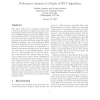Free Online Productivity Tools
i2Speak
i2Symbol
i2OCR
iTex2Img
iWeb2Print
iWeb2Shot
i2Type
iPdf2Split
iPdf2Merge
i2Bopomofo
i2Arabic
i2Style
i2Image
i2PDF
iLatex2Rtf
Sci2ools
IPPS
2007
IEEE
2007
IEEE
Performance Analysis of a Family of WHT Algorithms
This paper explores the correlation of instruction counts and cache misses to runtime performance for a large family of divide and conquer algorithms to compute the Walsh–Hadamard transform (WHT). Previous work showed how to compute instruction counts and cache misses from a high–level description of the algorithm and proved theoretical results about their minimum, maximum, mean, and distribution. While the models themselves do not accurately predict performance, it is shown that they are statistically correlated to performance and thus can be used to prune the search space for fast implementations. When the size of the transform fits in cache the instruction count itself is used; however, when the transform no longer fits in cache, a linear combination of instruction counts and cache misses is used. Thus for small transforms it is safe to ignore algorithms which have a high instruction count and for large transforms it is safe to ignore algorithms with a high value in the combi...
| Added | 03 Jun 2010 |
| Updated | 03 Jun 2010 |
| Type | Conference |
| Year | 2007 |
| Where | IPPS |
| Authors | Michael Andrews, Jeremy Johnson |
Comments (0)

